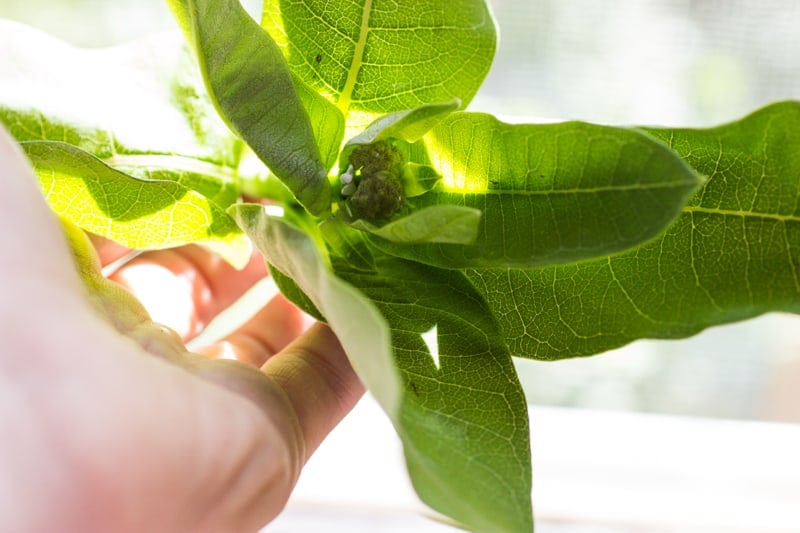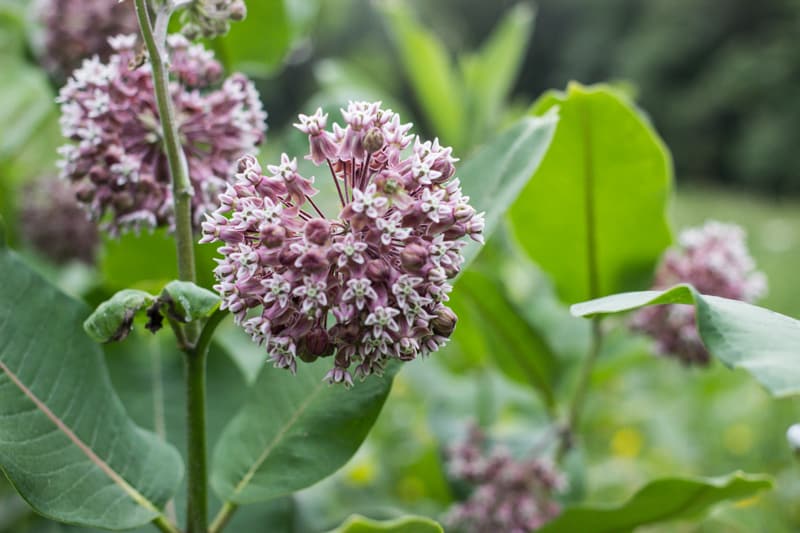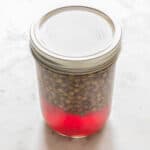Milkweed capers are a fun project I've been playing with for a few months. I've preserved plenty of unopened flower buds: nasturtiums, dandelions (personal favorite) chives, and day lilies to name a few. All of those make fun capers, but milkweed buds are fun since they can be harvested quickly, and in bulk.

In the beginning of the season, milkweed is a little shoot, it grows, developing leaves along the way, eventually forming buds on the top, which I also refer to as "raabs"- pretty much a pet name for buds that will eventually turn into flowers.

At first the buds are small, tight, and cook similarly to broccoli. As the season progresses, the buds change. The connective thread they grow from on the plant gets longer, making the buds look extra large, and bushy. After a while these change color, from green, to lavender/light purple. After the buds change color, they turn into flowers.
The bud's shape transformation and color change fascinate me, as well as the fact that they're edible at every single stage of their growth until the flowers dry in the sun, falling off the plant; each of these stages hold different possibilities.
The capers came about when I was picking the buds to cook this year and discovered certain patches of milkweed that were more exposed to sun than others. The ones in the sun were growing faster, and I had missed them at the green stage-all of the milkweed in the sunny area was purple and getting ready to flower.

When the bud stems are longer, and changing color, they don't stay tight and firm like when they're green and immature, they cook up kind of flat (literally speaking) and have a tendency to soak up oil in the pan or absorb too much sauce and get soggy. It's easy to pick the buds off the stem at this stage though, yielding perfect little orbs, which make me think capers, so that's where the Idea came from: different stages of the plant's life=different cooking techniques.
You could definitely take the tight green buds and pickle them too, but I know If I have a bunch of fresh milkweed buds, they never seem to stay around long enough to warrant pickling when green.
The capers turned out just like I thought they would, but with one exception: the liquid turned vibrant red. I expected the buds to lose their purple hue after sitting in brine but many of nature's colors, especially those in flowers, can transfer to liquids they are stored or cooked in, especially when those liquids contain alcohol or vinegar. Marigolds, calendula, violets, and other edible flowers will do this too.
To ferment or pickle your capers?
I wrote another recipe last year for capers made from dandelion buds, and you might be wondering what the difference is here. It isn't too different, but these are made with a lacto-fermented method as opposed to hot pickling with vinegar. Both techniques would be usable here, but the cold method preserved the almost caviar texture of the small buds better than a hot pickling method would, it's also way easier.
It's really important to understand the difference in flavor you get from pickling with vinegar vs. lacto-fermenting the milkweed capers. Vinegar is a good, quick way to lower the PH of a liquid, but fermenting will give you a more traditional flavor, and is also a little more exciting.

Fermented Milkweed Capers
Ingredients
- 25 grams kosher salt 1.5 tablespoon
- 500 grams water 2 cups
- 3 oz Milkweed unopened flower buds, picked apart, stems discarded as much as possible, rinsed clean
Instructions
- Combine the water and salt and whisk to dissolve. Pack the milkweed buds in a jar, and completely cover with the brine. If you can find a grape leaf or other leaf to hold them down, do it. I like to put a small stone in the top of the jar sometimes to hold things in place if they're floating. Screw on the lid.
- Leave the jar on the counter for 2 days to start fermenting, or leave out a bit longer if you want them to sour more quickly, then transfer to the fridge.
- Open the jar here and there to check on the capers and release carbon dioxide and to make sure water doesn't evacuate. If you've made other capers, know that milkweed capers can be more fickle and prone to mold, so keep an eye on them and stir often.
- I often put mason jars of ferments in another larger container to catch possible drips.
- After about 2 weeks the capers should have a nice flavor, but if you leave them in the fridge longer they will continue to age and develop until the pH is as low as it can go. More or less, the longer they sit, the better they will get, and you can let your palette be your guide.


Barbara
Thank you for this post! I am making these this weekend, made a shrub with the flowers last weekend! You are appreciated!
Alan Bergo
Thanks Barbara
Ramsons & Bramble
As ever, a beautifully shot, super inspiring foraged recipe! Not even considered pickling my own flower buds before... I am now!
Dan Farmer
I also made some milkweed "capers" this spring, Alan. I also packed some in salt, but those got very soft and unpleasant. The pickled ones are much better. I think I used a 50:50 water/vinegar ratio though, where you are using straight vinegar here. I also picked mine before the purple stage.
Lori
I have done this with milkweed buds as well and, yes, the liquid is beautiful and the capers tasty. I have also brined seed pods from nasturtiums and evening primrose. The primrose are just ok in my book. They serve to carry the flavor of the brine, but don't add a whole lot of flavor on there own. The nasturtiums I adore for their peppery hit. I have never brined their buds before they flower, but I imagine the taste would be similar, although I enjoy the toothiness with the seed pods. I use the nasturtiums capers as a garnish with infused vodka martinis.
Hilda
Thanks for bringing your older posts on capers to my attention as those were before I began following. I have been experimenting with all forms of capers also made from dandelion buds, milkweed buds and seed pods from malva, and have taken to fermenting them rather than pickling. Your variations are interesting and worth trying.
Alan Bergo
Hi Hilda, thanks for chiming in. I hadn't even thought of fermenting capers yet, what a great Idea! Like I allude to here, there is more than one way to do things, especially something as simple as a "caper" that could be packed in salt, fermented, pickled, ect. More than anything I want to help people understand these things can be done intuitively, and that recipes are only basic examples, the exception being the ph level of pickles, of course.
Kara Doucette
Bizarre... I was lying in bed recently, kept awake by the thought of all of the things that could be made into capers. I'm not kidding! Alas, I think I would be allergic to the milkweed sort. Regardless, everything on your blog always looks so intriguing - can we expect to see similar items at The Salt Cellar? I'm really looking forward to the opening!
-Kara
Alan Bergo
Hey Kara. This is a good question, and one that I've struggled with for a while.
Of course I want to share funky stuff with the public, but some things, (like mushrooms) are a no-no for now. We are also in Winter now, so I'm crippled a bit as far as access to ingredients. Compounding that is the fact that to supply a restaurant with this type of stuff would require me having elves to run out and pick it. At Heartland it was easier for me to hunt for things to put on the menu since I got two days off in a row, but for the next few months after we open, I will be working seven days a week, getting up at 5 am to pick stuff would kill me.
The good news is that I have been talking with a farmer, I've given him a list of things I like to hunt and he is going to try and grow them. On the top of the list is milkweed.
Your allergy brings in an interesting element to this too, since some of the plants people may have never had before, If I don't have a special disclaimer, I could get some bad press if someone gets a tummy ache, which does make me a little nervous.
Suffice to say I'm going to do my darndest to keep things interesting. Hope that gives at least a little clarity.